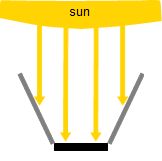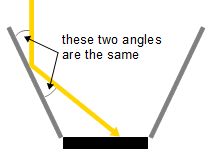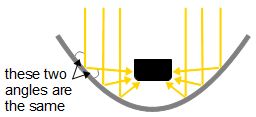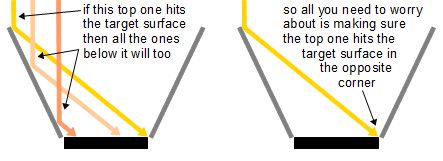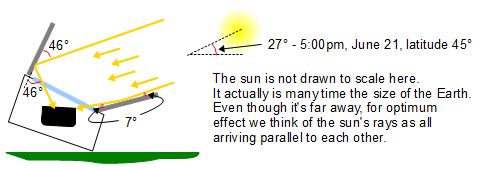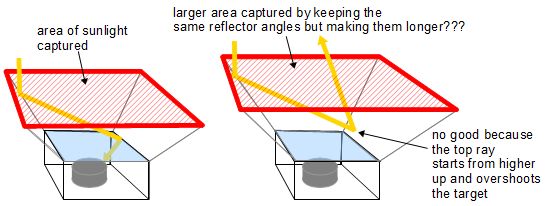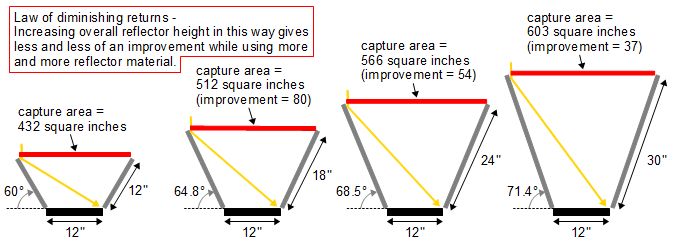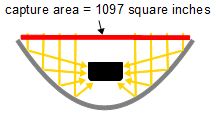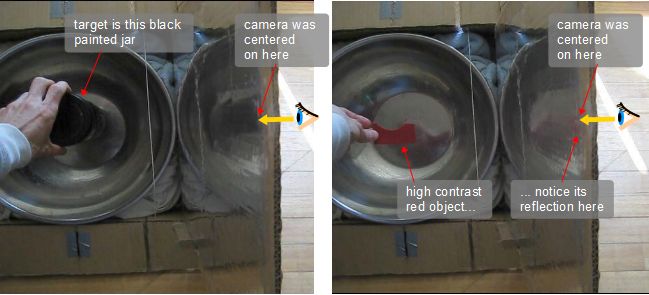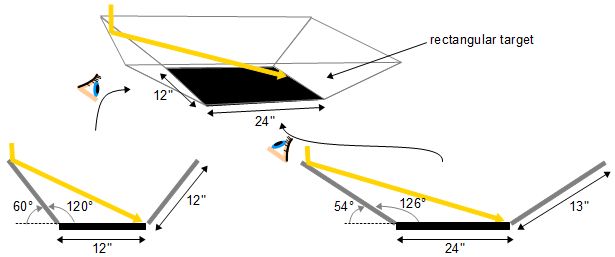You can design many solar reflectors for solar cookers, and other
things that need reflectors, without doing any mathematics.
In fact you can often get by knowing just two things:
|
1. If you are pointing directly at the sun then the sun's ray are
arriving straight at you
across your entire reflector.
|
|
2. The angle that a sun's ray reflects off your reflector is
the same as the angle that
it arrived at.
|
|
This is also true if you're designing a parabolic solar cooker
(see below), funnel solar cooker, CooKit, Pavarti, or any kind
of solar cooker that has reflectors.
A helpful rule of thumb, shown below, that works for many designs
is that the only sun's ray
you need to worry about is the one that reflects off the top of your
reflector. All sun's rays that reflect lower down will hit your
target surface somewhere as long as the top ray hits your target on
the opposite side. This is made use of in the calculators below.
|
|
Box oven solar cooker. The target we're trying to cover
with the reflector is the glass/plastic glazing.
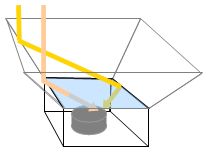 |
|
Using multiple reflector angles
Solar box oven cookers cannot always be tilted to face the sun
if the sun is low in the sky. Doing so may cause the cooking pot
to tip over, or if the pot is on a swivel base, it may already be
at it's maximum swivel angle.
To handle this situation you'd tilt the oven as much as you can.
Then, as shown in the following diagram, you'd put the top reflector
on a very steep angle and the bottom reflector on a very shallow angle.
Note that the angles are adjusted below such that the angles that the
sun's rays reflect off the reflectors are the same as the angles that
the sun's rays arrived at the reflectors. This is just as is decribed
at the very top above as the number 2 thing to know.
A handy tool for measuring angles is a protractor. If you don't have
one the you can download and print one from
here.
Improving the sunlight capture area
The capture area is basically the amount of sunlight you're capturing
and then concentrating using the reflectors. It's basically the
size of the hole made by the top of the reflectors. If you're
not familiar with this concept the click
here for a page all about
sunlight capture areas.
So does simply making the reflectors longer while keeping the angle
the same as shown in the following diagram improve the capture area?
The answer is no, since
the sun's rays that strike the top of the reflector will eventually
reflect back out without hitting the target area and the cooking pot
in a solar cooking oven in this example.
So you have to change the angle as well as the reflector length (see
the following diagram.) Two methods are given below to show
how to do this. However, you can see that as you increase
the reflector length, and hence the total height of the reflector,
more and more, the improvement you get in capture area is less and less.
This is because of the uniform shape of the reflectors and/or
because of the location of the target.
If you really want to increase your capture area a lot then a
better way is to start moving your target in front of the reflector
as shown in the following diagram. Compare the capture area of the
parabolic reflector below, 1097 square inches, to the capture area
of rightmost reflector above, 603 square inches. Note: they are
both drawn with the same scale.
A calculator for working out your capture area for some types of
reflectors without doing any math is given below.
Two methods for figuring out solar reflector angles, lengths, ...
|
A popular thing to do is to make your reflector length the same
as your target width. In that case the optimal reflector
angle is around 60 degrees and the above rule of thumb regarding
the top ray will just happen.
|
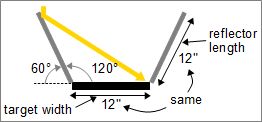
|
Two methods are suggested below for figuring out your own
parameters. You can either:
- make your reflector by eyeballing things and getting a very
accurate result as talked about next, or
- you can use some of the calculators given further below.
Method 1 - Eyeballing to get optimum reflector angle
Simply put, you pretend that your eye is the sun and you look
at your reflector from the sun's perspective, as shown below.
If you see your target surface then that means the sun will too.
Look straight down at what is reflected in the top of your reflector.
Keep adjusting the reflector angle until you see the opposite part
of the target area reflected into your eye. Once you see that then
you know the rest of the reflector is good too, as discussed above.
If it helps, put a brightly colored object in the target area,
like the red ball shown below.
I used this technique very successfully on my
cone solar cooker.
The following photos and video show in great detail how I did it.
Finding the optimum reflector angle
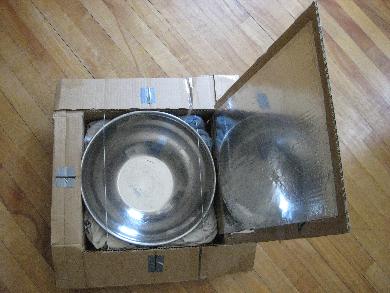 |
|
Method 2 - Some helpful calculators (no math needed)
The calculators below are for finding the optimum reflector angle, an
angle that will cause a reflector to cover the entire target area.
This works for designs where you need only make sure that the sun's
ray that hits the top of the reflector reflects to the opposite
side of the target.
Square target versus rectangular target
If your target is square, i.e. all sides are the same length, then you
need only use one of the calculators, depending on what information
you have available, reflector length or vertical height.
If you target is a rectangle, i.e. shorter in one direction and longer in the
other, then you need both calculators. That's because the reflectors
will be at different angles and have different lengths in order to
cover the entire target area as this diagram shows.
So if your target is a rectangle,
- if you have a reflector length
in mind already, start with the first calculator and give it the
reflector length and the length
of the longer side of the target. This will then tell you
the optimum angles and the vertical height.
Then go to the second
calculator and give it that vertical height and the
length of the shorter side of
the target. It will then tell you the optimum angle and a
shorter reflector length.
- if you have a vertical height
in mind already, start with the second calculator and give it the
vertical height and the length
of the longer (or shorter) side of the target. This will
then tell you the optimum angles and the reflector length.
Then go to the second
calculator and give it that reflector length and the
length of the shorter (or longer) side of
the target. It will then tell you the optimum angle and a
different reflector length.


